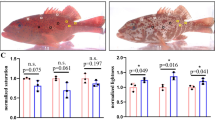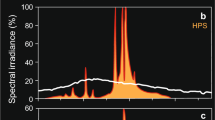Abstract
The influence of light on colour patterns and behaviour of the coral-reef fish Chaetodon melanotus were investigated under aquarium and field conditions. Colour pattern and fin position are correlated with agonistic behaviour: they were used as criterion for analysing the behavioural patterns during morning and evening transition.Readiness for attack is correlated with a darkening of the analfin. A specimen with yellow anal fin and spread dorsal fin is more likely to flee. The colour patterns vary during day, twilight, and night time. The speed of colour change was measured experimentally; it appears to be hormonally regulated. During twilight, 5 different colour patterns are related with certain anal-fin colour-patterns and dorsal-fin positions. Swimming activity decreases with reduction in irradiance, while the readiness to flee increases. In groups, specimens become more territorial with diminishing day light. Territorial aggression can be light-dependent; no territorial aggression was observed at illuminations less than 50 lux. Behaviour and concomitant coloration-changes during the evening and morning transition periods are interpreted as adaptational protections against predators. The remarkable white eyespots in the twilight body-coloration could represent a warning signal, and could also have a somatolytic effect. The increased readiness to flee during dusk and dawn may be a behavioural mechanism for reducing predator pressure.
Zusammenfassung
-
1.
Im Aquarium und im Freiwasser wurde der Einfluß des Lichtes auf Körperfärbung und Dämmerungsverhalten des tagaktiven Schmetterlingsfisches Chaetodon, melanotus untersucht.
-
2.
Die Tag-, Dämmerungs-und Nachtfärbung dieses Fisches sind beschrieben.
-
3.
Agonistisches Verhalten ist in der Tagfärbung mit bestimmten Farbmustern korreliert. Ein Tier mit dunkler Analflosse ist eher zu Angriff, eines mit gelber Analflosse und aufgestellter Dorsalflosse eher zur Flucht bereit.
-
4.
Die Geschwindigkeit der Farbänderungen wurde experimentell bestimmt und scheint hormonell reguliert zu sein.
-
5.
Fünf verschiedene Dämmerungsmuster sind mit der Färbung der Analflosse und der Dorsalflossentellung verknüpft.
-
6.
Die Schwimmaktivität sinkt mit abnehmendem Licht, während gleichzeitig die Fluchtbereitschaft steigt.
-
7.
Bei abnehmendem Licht (>90 und 50 Lux) werden in Gruppen gehaltene Fische standorttreu; die territoriale Aggression steigt. Bei Beleuchtungsstärke unter 50 Lux wurde keine offene territoriale Aggression beobachtet.
-
8.
Die Verhaltens-und Farbänderungen während der Dämmerung werden als Anpassungen gegen den Freßfeind interpretiert. Die auffälligen weißen Augenflecken im Dämmerungsfarbkleid könnten den Freßfeind abschrecken und zusätzlich somatolytischen Effekt haben. Durch erhöhte Fluchtbereitschaft ließe sich der Feinddruck vermindern.
Similar content being viewed by others
Zitierte Literatur
Baehrends, G. P.: Ethological studies on Lebistes reticulatus Peter. I. Analysis of the male courtship pattern. Behaviour 8, 249–334 (1955).
Barlow, G. W.: Ethology of the Asian teleost Badis badis. V. Dynamics of fanning and other parental activities, with comments on the behaviour of the larvae and postlarvae. Z. Tierpsychol. 21, 99–123 (1964).
Blest, A. D.: The function of eye-spot patterns in the Lepidoptera. Behaviour 11, 209–255 (1957).
Collette, B. B. and F. H. Talbot: Activity patterns of coral reef fish with emphasis on nocturnal-diurnal changeover. Sci. Bull. natn. Hist. Mus. Los Angeles Cty 14, 98–124 (1972).
Cott, H. B.: Adaptive coloration in animals, 418 pp. London: Methuen 1957.
Eibl-Eibesfeldt, I.: Freiwasserbeobachtungen zur Deutung des Schwarmverhaltens verschiedener Fische. Z. Tierpsychol. 19, 165–182 (1962).
Fricke, H. W.: Chaetodon melanotus (Chaetodontidae). Übersprungfressen beim Frontaldrohen. Film E 1851/1970. Göttingen: Encycl. cinem. 1971a.
—: Chaetodon melanotus (Chaetodontidae). Droh-und Kampfverhalten. Film E 1580/1970. Göttingen: Encycl. cinem. 1971b.
—: Korallenmeer, Verhaltensforschung am tropischen Riff, 223 pp. Stuttgart: Belser Verlag 1972.
Hobson, E. S.: Diurnal-nocturnal activity of some inshore fishes in the Gulf of California. Copeia 1965 (3), 291–302 (1965).
—: Activity of Hawaiian reef fishes during the evening and morning transition between daylight and darkness. Fish. Bull. U.S. 70, 715–740 (1972).
Morris, D.: The reproductive behaviour of the ten-spined stickleback (Pygosteus pungitius L.). Behaviour (Suppl.) 6, 1–154 (1958).
Rasa, O. A. E.: Territoriality and the establishment of dominance by means of visual cues in Pomacentrus jenkinsi. Z. Tierpsychol. 27, 825–845 (1969).
Starck, W. A. and W. P. Davis: Night habits of fishes of Alligator Reef Florida. Ichthyologica 38, 313–356 (1966).
Author information
Authors and Affiliations
Additional information
Communicated by O. Kinne, Hamburg
Herrn Professor Konrad Lorenz zum 70. Geburtstag gewidmet.
Rights and permissions
About this article
Cite this article
Fricke, H.W. Der einfluß des lichtes auf Körperfärbung und dämmerungsverhalten des korallenfisches Chaetodon melanotus . Mar. Biol. 22, 251–262 (1973). https://doi.org/10.1007/BF00389179
Accepted:
Issue Date:
DOI: https://doi.org/10.1007/BF00389179




